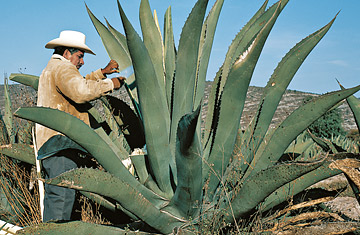
A farmer in Hidalgo, Mexico, extracts agua miel from Agave salmiana.
Afua Cooper already loved honey and maple syrup, so when a friend suggested last year that she try agave, a natural sweetener produced in Mexico, she was happy to pour it into her tea and pronounce it "delicious." But for Cooper, a clothing designer in Brooklyn, N.Y., there was an even stronger selling point. She has a family history of diabetes, and ingesting agave, which has a glycemic index lower than table sugar and honey, causes a relatively lower spike in blood sugar. "I use agave as part of my overall health program," Cooper says.
These days agave (pronounced ah-gah-vay) is generating its own sweet spot for small businesses. "Consumers are interested in agave as a replacement for other natural sweeteners," says Michelle Barry, president of the Hartman Group's trends division, Tinderbox. Natural-products companies are rushing to fill that demand. There were 176 new products containing agave launched in the U.S. in 2007, compared with 56 in 2003, according to DataMonitor's Productscan Online. Sales are sweet too. Market-research company Spins reports that revenues for "other liquid sweeteners," a category that includes agave, rose to more than $10.3 million last year, a 50% jump from 2006.
Wholesome Sweeteners, based in Sugar Land, Texas (a town that was built around the Imperial Sugar Co.), added organic agave to its line of natural and organic sweeteners in 2006. Using only the juice of the blue agave plant, the same liquid distilled to make tequila, Wholesome sources its agave from about 4,000 acres (1,600 hectares) of fields in the Mexican state of Jalisco. Retailing on the shelves of Whole Foods, Wegmans, Kroger and other supermarket chains, agave products accounted for 15% of Wholesome's sales last year, compared with only 3% in 2006. "Agave is great-tasting and a healthier alternative to refined sugar, which is why it has become so popular," says Pauline McKee, the company's co-founder and vice president of marketing.
Madhava Honey, in Lyons, Colo., began selling agave in 2002 but uses Agave salmiana, a different species that is grown and harvested by the Hnahnu, an indigenous community in the Cardonal Valley, in the state of Hidalgo, northeast of Mexico City. Madhava--the name comes from a Sanskrit word for sweet--buys a large percentage of the Hnahnus' total output annually, says company president Craig Gerbore. Both types are similar in flavor, although blue agave has a more lingering taste than salmiana. Can agave shoppers in Whole Foods and Giant tell the difference? Who knows, but they seem to be buying it. Madhava's agave sales were about $6 million last year--two-thirds of the company's revenue--up from $2.9 million in 2006.
Both Wholesome and Madhava rely on two of Mexico's largest agave-nectar manufacturers--Iidea and Nekutli, respectively--to process the juice from the harvested plants into agave that's ready to be used in drinks or recipes. The Mexican companies also sell the product worldwide, and agave is growing in popularity in Germany, Japan and New Zealand, Gerbore says.
In the U.S., the most promising new market for agave may be other companies. Gerbore says he has noticed increasing sales to bars, where it's used as a cocktail syrup; to restaurants; and to granola, ketchup and ice cream manufacturers, which use the sweetener as an ingredient. Food companies may be hoping that listing agave as a sweetener will attract those health-conscious consumers who are already trained to look for and avoid particular sugars like high-fructose corn syrup.
Still, experts caution that agave's low glycemic index is hardly a reason to start guzzling the sweetener--it is still sugar, after all. "Ingested sugar is either burned as fuel or stored as fat, regardless of the initial glycemic response," says Dr. David L. Katz, director of Yale University's Prevention Research Center. "Excess of any sugar, natural or not, can compromise your health." Cooper realizes the value of moderation, but she admits to "indulging a bit more and not measuring so carefully" with agave, given its low glycemic index. She, like so many other consumers, is still enjoying agave's natural sugar rush.